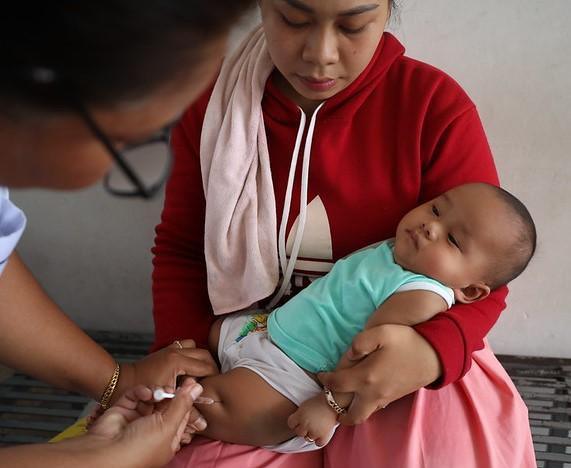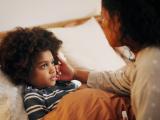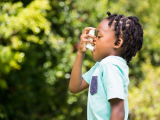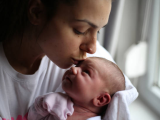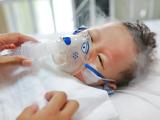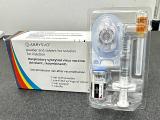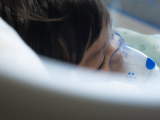Infant hospitalization rates for respiratory syncytial virus (RSV) were 28% to 43% lower in 2024-25, the first US respiratory-virus season with broad availability of a maternal RSV vaccine (Abrysvo) and the preventive monoclonal antibody nirsevimab (Beyfortus) for infants, estimates a study in Morbidity and Mortality Weekly Report.
A separate study from the previous RSV season published in Pediatrics finds that, although 72% of infants were protected against RSV through maternal vaccination or infant receipt of nirsevimab, racial disparities and nirsevimab shortages were common, leaving many infants unprotected for weeks to months.
The maternal vaccine is recommended for women during weeks 32 to 36 of pregnancy from September to January in most of the United States, and nirsevimab is advised for infants aged 0 to 7 months in their first RSV season and children aged 8 to 19 months at higher risk for severe RSV in their second season. Both products were rolled out during the 2023-24 RSV season.
Greatest benefit in youngest babies
For the first study, a Centers for Disease Control and Prevention (CDC)-led team compared RSV hospitalization rates among children younger than 5 years after maternal RSV vaccine and nirsevimab in 2024-25 with those from 2018 to 2020. The evaluation used data from the RSV-Associated Hospitalization Surveillance Network (RSV-NET; 300 hospitals in 13 states) and the New Vaccine Surveillance Network (NVSN; 7 medical centers).
In total, 18,389 RSV hospitalizations were identified, including 11,681 in 2018-20 and 6,708 in 2024-25. Median patient age was 6.7 months and 14.7 months in RSV-NET and 6.3 months and 12.7 months in NVSN in the earlier and later seasons, respectively. Cumulative RSV admission rates among infants 0 to 7 months old were lower in 2024-25 than in 2018-20 (8.5 vs 15.0 per 1,000 children in RSV-NET and 10.7 vs 14.8 per 1,000 in the NVSN).
Higher RSV-associated hospitalization rates during 2024–25 compared with 2018–20 among children in older age groups, who were largely ineligible for RSV prevention products, suggest a more severe 2024–25 season overall.
RSV-NET data showed that RSV hospitalization rates among infants aged 0 to 7 months were an estimated 43% (95% confidence interval [CI], 40% to 46%) lower in 2024-25 than in 2018-20, while the NVSN found a reduction of 28% (95% CI, 18% to 36%).
The greatest drop in admission rates was seen in babies aged 0 to 2 months, at 52% (95% CI, 49% to 56%) using RSV-NET data and 45% (95% CI, 32% to 57%), per the NVSN. Reductions were largest during peak hospitalization periods.
Among children aged 8 to 19 months and 20 to 59 months, RSV admission rates were higher in 2024-25 than in 2018-20. Differences in weekly and monthly rates between 2024-25 and 2018-20 were similar to observed differences in cumulative rates in all age-groups.
"Higher RSV-associated hospitalization rates during 2024–25 compared with 2018–20 among children in older age groups, who were largely ineligible for RSV prevention products, suggest a more severe 2024–25 season overall and indicate that observed reductions in hospitalization rates among younger infants might be underestimated," the researchers wrote.
A sensitivity analysis of NVSN data that excluded Houston, Texas, where prevention products weren't widely available before the RSV season began there, the estimated reduction in hospitalization rates among infants aged 0 to 7 months in 2024-25 was 56%. The NVSN rate reduction was 71% when Houston was excluded.
"These results support the recommendations of the Advisory Committee on Immunization Practices to optimize population-level impact by administering RSV prevention products as early as possible in the season (i.e., before peak RSV transmission) on the basis of local epidemiology," the authors concluded. "Increased and earlier use of RSV prevention products during future seasons might lead to even larger reductions in pediatric RSV–associated hospitalizations."
Highest uptake among Asian moms, babies
The second study was based on data on 36,949 mother-infant dyads and rates of maternal RSV vaccination and nirsevimab receipt at 10 Vaccine Safety Datalink (VSD) health systems from September 2023 through March 2024. The three most common maternal races were Hispanic (34.5%), White (29.9%), and Asian (17.8%).
Nirsevimab shortages left some unvaccinated infants born in September and October without protection for weeks to months because they were not able to receive the product at birth.
A total of 71.7% of infants were immunized against RSV via either maternal vaccination (31.9%) or nirsevimab (42.5%), with the highest rate among those born to Asian mothers (83.7%). Racial disparities were observed, with 60.5% coverage among infants born to Black, Middle Eastern, or North African women. These findings, however, should be interpreted with caution, given the small numbers of women in these groups, the authors said.
Coverage ranged from 59% to 78% by birth month, with nirsevimab most often given to babies born in the fall. Vaccine uptake ranged from 63.6% among infants born to women aged 50 to 55 years to 81.4% in those with mothers aged 12 to 17 years.
"Despite the challenges posed by the roll-out of 2 novel products as well as shortages and delays in the 2023 to 2024 season, participating VSD sites were able to achieve high RSV immunization coverage," the investigators wrote. "However, nirsevimab shortages left some unvaccinated infants born in September and October without protection for weeks to months because they were not able to receive the product at birth."
Trust issues, healthcare barriers
In a commentary on the second study, Haya Hayek, MD, of Vanderbilt University, and colleagues said that, despite the availability of RSV-prevention products, significant barriers to delivery remain, including increasing parental vaccine reluctance since the COVID-19 pandemic.
The growing influence of social media misinformation, declining trust in public health institutions, and health care provider burnout further contribute to challenges in uptake.
"The growing influence of social media misinformation, declining trust in public health institutions, and health care provider burnout further contribute to challenges in uptake," they wrote. "Beyond vaccine acceptance, disparities in health care access further complicate implementation. Factors such as insurance coverage, provider availability, and geographic barriers also create potential gaps in protection."
Hayek and colleagues called for strategic policymaking, effective communication, and a commitment to equity. "The opportunity before us is unprecedented, and with coordinated global efforts, RSV prevention can become a reality for all infants, regardless of geography or socioeconomic status," they wrote.
